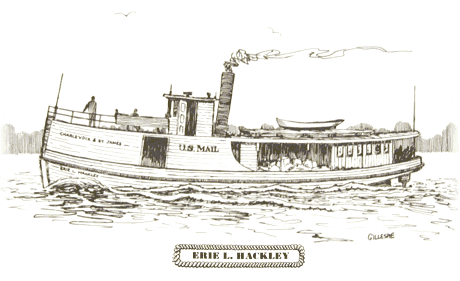|
 | |||||
The Erie L. Hackley and the 1900 Ferry War Today we are so used to the Emerald Isle and the Beaver Islander serving as reliable regular ferries to the mainland that the idea of there being competing services is almost unthinkable. Yet off and on, particularly in the year 1900, this has been the case. People still talk about the daring and enterprise of Captain Peter D. Campbell, who purchased the Hackley in 1893. At that time his purpose was to run it as a tour boat for Chicago's Columbian Exposition. He had the cabin expanded to include 16 folding double berths for excursions he ran out of Whitehall so his passengers could sleep on board; the Chicago hotels were expensive and usually full. The next season he used her as a ferry between White Lake and Muskegon. In 1896 Captain Campbell brought her to Charlevoix to take over the mail run to Beaver Island from the Nellie, the first steam tug to serve as our ferry. Coincidentally, the Nellie took over the White Lake run. The two ships passed each other on April 8th going in opposite directions. Reaching shore, the Nellie's crew complained that Captain Campbell was cursing them as they passed. When he heard this, he laughed it off, explaining he had only wished them "God speed" in Gaelic! The Hackley contracted to begin the mail run on April 1st and go as late into the winter as was safe. As we know, the waters turn rough late in the fall, and she was usually pulled in mid-December. In the spring of 1899 she was given a considerable overhaul with oak planking: new covering boards, new bulwarks, and some new hull planking. That November, though, competition appeared when Captain Neil Gallagher bought the steamer Joe in Muskegon and announced he would run it from St. James on behalf of the Wolverine Fish Company. The Joe ran much later than the Hackley that season, still being in the water on January 17th. Captain Campbell had been forced to pull his boat to have the cylinder rebored. The battle was on, and Campbell did everything he could to prepare for the start of the 1900 season. Still, the Joe got a week head start on the Hackley, but the two captains were at least able to agree on a schedule of three trips a week, alternating days. Everything would have been fine except that August Captain O'Connor of Harbor Springs threw his hat into the ring as well, buying the Oval Agitator from the Booth Fisheries and announcing he would compete for traffic to Beaver Island. The Agitator was newer, larger, and faster than the Hackley, and Captain Campbell's future looked dim. The normally cheerful man seemed particularly dispirited to his many friends. Luckily for him, the Agitatror found a more lucrative run (to Sturgeon Bay) by September, and pulled out of the contest. Then Campbell's luck doubled when the Joe suffered misfortune: first she sprang a serious leak in her stem pipe and had to be towed to port by a tug constantly running its pump, and then she was libeled for debt and seized by the U. S. Marshals. They had her towed to Charlevoix, where she sank at the dock.
With the competition eliminated, the Hackley ran with pride and gusto into January of 1901. She needed work, though, and at times Captain Campbell charted the Columbia to take her place while she was in dry-dock. The Columbia too needed work, though, which created an opening for the Margaret McCann. In January of 1902 a partnership formed to buy the Agitator, which had twice the capacity of the Hackley. They renamed her the Beaver. By the 20th of March she was fitted out, and took over as our ferry by default. The Hackley, unable to compete, found easier work ferrying light-hearted tourists around the Manitous. The war was over, and the Beaver came out as the undisputed winner. | |||||
